Plan your Gansu Tour in autumn? Gansu Province has a varied landscape with wide species of plants. Its north is the famous Hexi Corridor flanked by Qilian Mountains and Longshou Mountains; its south is the transitional area from the loess to Qinghai -Tibetan Plateau; its east part is dominated by the mountainous areas and the loess plateau.
Its diversity of landscapes and plants offer Gansu much photography opportunity when autumn comes, red maples, golden poplar trees, white reeds, yellow alpine meadows, presenting a palette of colors pleasing your eyes.
If you plan to visit Gansu in autumn, we are going to reveal you the best places to see the foliage in Gansu. The late September and October are the best time to enjoy the autumn colors in Gansu.
1. Red Colors at Xinglong Mountain National Nature Reserve 榆中兴隆山赏红叶
Xinglong Mountain National Nature Reserve is within Yuzhong County, about 45 km to the southeast of Lanzhou, the capital city of Gansu. The nature reserve has an area of 29583.6 hectares, at the altitude between 1800 m and 3670 m, yearly average temperature around 4.1 ℃, annual precipitation 621 mm. Xinglong Mountain is composed of two peaks with a stream running through in the middle.
Autumn is the most beautiful season in Xinglong Mountain which is blanketed by the multi-colored red leaves of maple trees. The cascading colors covering the mountain, a stunning autumn view, not overshadowed by “The Red Leaves of Fragrant Hill in Beijing”.
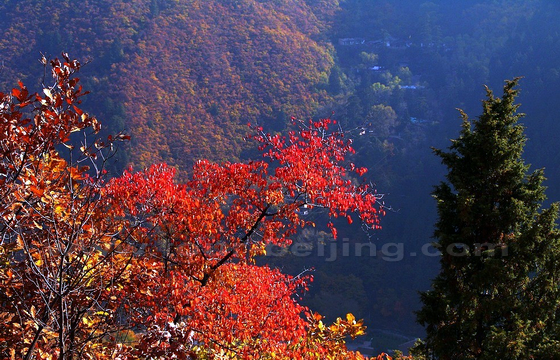
2. Autumn View at Zhangye Heihe National Wetland Park 张掖黑河国家湿地公园秋色
Zhangye is an ancient town on the middle of the Hexi Corridor synonymous with the Silk Road. Zhangye is located on the delta formed by the Heihe River. Zhangye Heihe Wetland Park is on the northern suburb of Zhangye, with an area of 1733 hectares, closely connected with the city of Zhangye. The wetland park is an important part of the eco-system of the Zhangye oasis in the dry inland area. In addition to the Hei He River feeding the wetland, the water in the wetland also comes from the underground.
Zhangye wetland features a varied landscapes of rivers, marshes, wet meadows, man made lakes, ponds, a multi-forms of wetlands. Autumn is a good time to visit the wetland. When autumn comes, Zhangye Heihe National Wetland Park turns into a glistering ocean of golden reeds, a touch of solitude and tranquility.
3. Autumn Scene at Zha Ga Na Mountain 甘南扎尕那
Zha Ga Na Mountain is witin Zagana Dongwa Village, Yiwa Township, Diebu County, Ganna Tibetan Autonomous Prefecture in Gansu Province. It takes about 7 hours’ drive from Lanzhou to Diebu County and another 28km from the seat of Diebu County to Zhagana Mountain, an undeveloped scenic area.
Between June 1925 and March,1927, Joseph Charles Francis Rock (1884 -1962), an Austrian American explorer, botanist and geologist, made several expeditions into Diebu area including Zhagana Mountain. He exclaimed that ” I have never seen the magnificent scenery before. If the writer of the book of Genesis had seen the beautiful in Diebu, he would have put the birthplace of Adam and Eve here. I’m amazed by Diebu, an expansive forest like a natural botanical Museum, absolutely a maiden place. It will become a mecca for those who love nature.”. Dibu boasts the unique conifer trees.
In 2009, China National Geography sponsored an activity of looking for Top 10 “Non-famous Mountais in China” and Zhagana Mountain was listed as No.4. Zha Ga Na, literally”Stone Box” in Tibetan, is a complete natural “stone city”at the altitude of 3970 m. North of the massive Zhagana Mountain is the grand and bright treeless rock peak known as “Stone Mirror Mountain”; Zhagana Mountain is ringed by the steep rock peaks on its east and south. The Zhagana Mountain Scenic Area is totally natural and unfurnished. You may stay overnight in a Tibetan home, a original and primitive Tibetan tribe.
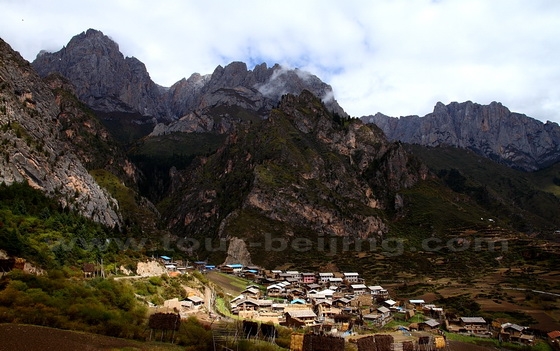
4. Autumn Hues at Jinta Poplar Tree Forest 金塔胡杨林
Jinta Poplar Tree Forest is located in the west of Jinta County within Jiuquan City of Gansu Province. Jinta Poplar Tree Forest covers an area of 5333 hectares, surrounded by the expansive plant belt of date trees, birch trees and red willows, typical plants in the northwest China.
Poplar trees spread densely and grow well, ranking the top in the province. It is said that the poplar trees have an unusual vitality that enables it to survive for 3,000 years by living for one thousand years, standing still for another one thousand years after death, and remaining not rotten for one thousand years. Autumn is the best season to view the autumn hue of poplar trees at Jinta.
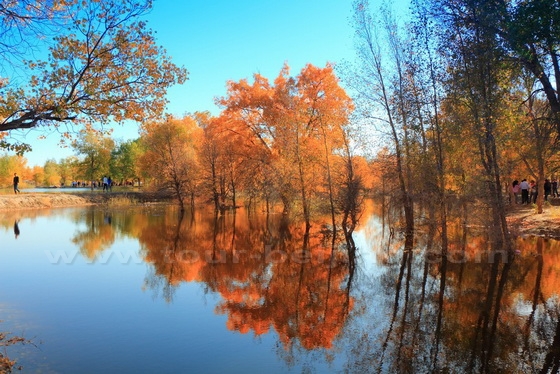
5. Kulong Gorge at Shandan Horse Farm in Zhangye 山丹马场窟窿峡
Shandan horse farm is located within the Qilianshan Mountains in Shandan County, 130 km southeast of Zhangye. Shandan horse farm is the largest horse farm with the longest history in the world, back to Han Dynasty as early as 1300 years ago. Shandan horse farm used to be a war horse breeding center for China’s successive dynasties. For the 50 years from 1949 t0 2001, Shandan horse farm were operated by China’s military. In 2001, the horse farm ws turned over to the China Animal Husbandry Group since cavalry grew a less essential l part of Chinese military defense.
Shandan horse farm has been the war horse breeding center of Chinese successive dynasties royal from Han dynasty. As early as 3000 years ago, there had already started horse breeding. The horse farm has an area of 2,195 square kilometers, slightly larger than two HKSAR, it’s the Asia’s largest horse farm.
From 1949 to 2001, Shandan Horse farm was belonged to the Chinese military and the principal aim is to provide riding horses for the military, it had experienced nearly 50 years of military management. In 2001, Shandan horse farm was handed over to the China Animal Husbandry Group, as cavalry became a less crucial part of Chinese defense system
In the southeast of Shandan horse farm, there is a gorge known as Kulong Gorge ( literally a gorge with holes and caves), a strange and weird landscape. Clear and limpid water passes through the gorge filled with holes and caves, making louder sounds like playing music. Even you walk the meadows along the banks of the river running in the gorge, you can feel the running water under your feet. When autumns comes, the pine trees, red leaf trees and flowers blanket the gorge, a soul-recharging experience.
6. Fall Colors at Dingxi 甘肃定西秋色
Once an ancient city along the Silk Road, Dingxi is located in the heart of Gansu Province, about 107 km to the southeast of Lanzhou, oft-lauded as “the East Gate of Lanzhou”. Dingxi is also nicknamed as “The City of Potatoes”.
In the Anding District of Dingxi, the terraced trees hugging the hillsides offer much photography opportunity. This is the result of “Returning arable land to forests and meadow”, a local policy of preserving the ecological environment . Now this area has become a good spot for autumn colors in Gansu.
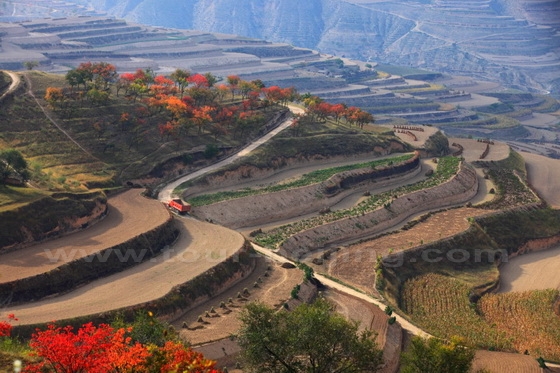
7. Autumn Colors at Xixia Gorge Eulogy of Chenxian County成县西狭颂
Chenxian County is located in the mountainous region under the jurisdiction of Longnan City in Guansu. Chenxian is recognized as one of the 33 “Thousand-Year-Old Towns in China”. Also oft-lauded as”A Township of Walnuts”.
13 km on the west of Chenxian County lies a National AAAA scenic spot known as “Xixia Gorge Eulogy”. The gorge is named after a famous cliff carvings in the gorge known as “Xixia Gorge Eulogy” which were carved in the year 171 AD. The gorge is itself gorgeous when autumn comes.
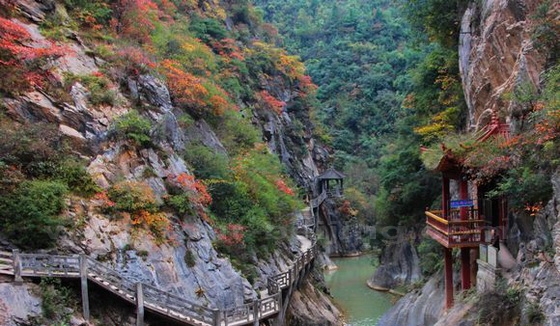
Add-on:
Top 10 Places to Visit in Gansu
Any questions, just drop a line.





